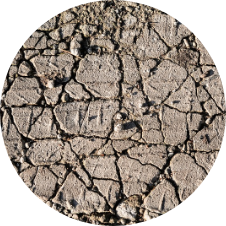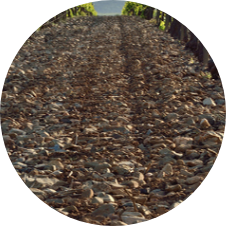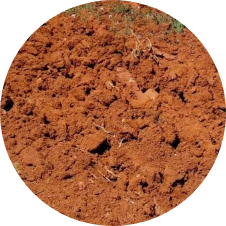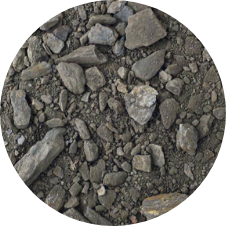¿Qué propone la cultura slow para vivir mejor? Este estilo de vida propone disfrutar con calma. Descubre cómo este movimiento se cruza con el vino orgánico


Not every piece of land where grapes are grown is exactly the same. Many are comprised of different mixes of soils, which lend unique characteristics to the vines that grow in them. Because of this, there are several characteristics that we can associate with a particular wine, depending on the soil in which its grapes grow. In the following, we’ll give a brief summary of the characteristics you can find in some of the most common types of soils:
 Sandy
SandySoils are considered sandy if they contain at least 50% sand. They usually have a porous texture that is very good for draining moisture, including in rainy areas. Wines like Tempranillo from the Spanish region of Ribera del Duero are characterized by their origin in zones defined by their sandy soils.
 Clay
ClayClay soils tend to be cooler and retain more water. They often have sub-categories, and are internationally recognized for being advantageous for the production of Pinot Noir and Chardonnay grapes, two of the most widely-consumed varieties in the world.
 Granitic
GraniticWines made from grapes cultivated on this kind of soils exhibit mineral aromas, hints of saline, and good levels of acidity.
 Limestone
LimestoneFrom these soils, wines tend to have higher levels of alcohol, lower levels of acidity, and often very good quality. It’s important to mention that an excess of limestone and any mistake in the rootstock election can cause important imbalances in the precise development of the grapevine.
 Chalk
ChalkThese soils have low levels of organic material, and don’t allow the roots to penetrate very deeply into the earth. The heat of the sun reflects off the soils, which helps the grapes ripen. They produce wines with greater levels of alcohol, with mineral notes and complex flavors.
 Loam
LoamThis is one of the soil types with the greatest agricultural productivity, as it contains a mix of sand, silt, and clay ideal for cultivation. Generally it’s made of 45% sand, 40% silt, and 15% clay, but it may have variations, with one element in greater quantity than others, which can make a soils sandy loam, loamy clay, or loamy, depending on the proportions.
{{cta(’46b2a79c-e5e3-4ad9-b70f-5bc6da4cc50f’)}}
Chile’s Casablanca Valley has excellent conditions for cultivating grapevines, as the soils are alluvial in origin, with a sandy loam texture, good permeability, low water retention, and are shallow, with low levels of organic material and little alkalization. You could say that the soils possess the perfect characteristics for producing balanced vines, a principal factor that makes Casablanca’s wines so special, unique, and high quality.

The minerality and quartz present in the valley’s soils also mean wines with unique characteristics, principally those from the highest part of the valley. A good example that perfectly reflects the personality these soils imprint on the wines are our Ritual wines, all from selected blocks on Viñedos Veramonte’s Casablanca estate.
On the other hand, Colchagua is a much warmer zone that translates into wines with ripe red fruit flavors and exquisite aromas. The Apalta zone, meaning “tremor” in the local language, is a small horseshoe-shaped valley that produces some of the most renowned wines in all of Colchagua. To the north, east, and west, it’s surrounded by peaks that reach 600 meters a.s.l. This sub-valley benefits from breezes generated between the Pacific Ocean and the Andes Mountains.
The Tinguiririca River forms the southern border of this valley, and helps regulate temperatures. It also brings necessary water for irrigation. The clay-sand soils are mixed with volcanic rocks. Here red varieties thrive, including Carménère, like our Primus Carménère, The Blend, and Neyen, all from Viñedos Veramonte’s Apalta estate.
Another well-known zone in Colchagua is Marchigüe, less than 30 km from the Pacific Ocean, and one of the winemaking zones closest to the coast in the valley. Located in the Coastal Mountain Range, the gentle hills have deep granitic soils covered by large quantities of clay on the surface, all under the influence of the ocean breezes that help refresh the vineyards.
This allows the production of fresher wines with lower levels of alcohol and a great fruit-forward aromatic expression on the nose and palate. Veramonte’s Reserva red wines come from this estate.
{{cta(’00a74473-02cf-4f1d-a6a3-c98d79976b22′)}}
¿Qué propone la cultura slow para vivir mejor? Este estilo de vida propone disfrutar con calma. Descubre cómo este movimiento se cruza con el vino orgánico
Las cepas de vino en Chile nacen de uvas que se nutren y crecen en condiciones muy especiales, las cuales dependen del valle en el que fueron plantadas.
🌎 El clima, la posición geográfica y la experiencia acumulada de los enólogos hacen del vino chileno uno de los mejores del planeta. ¡Te contamos por qué!